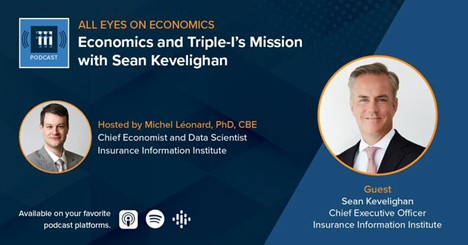
By Lewis Nibbelin, Visitor Blogger for Triple-I
Insurance coverage protection has lengthy been “a grudge buy – a once-or-twice-a-year transaction that many shoppers didn’t wish to take into consideration,” Triple-I CEO Sean Kevelighan mentioned in a latest episode of the “All Eyes on Economics” podcast.
However in at present’s dynamic financial setting – marked by inflation the likes of which most insurance coverage purchasers have by no means skilled – it has turn out to be extra necessary than ever for shoppers and policymakers to grasp how insurance coverage is underwritten and priced.
One among Triple-I’s chief aims is “serving to folks perceive what insurance coverage can do for you, but additionally what you are able to do to vary the state of affairs,” Kevelighan instructed podcast host and Triple-I Chief Economist and Knowledge Scientist Michel Léonard. “The narrative appears, a minimum of from my standpoint, to be much less about, ‘Why is my insurance coverage so excessive?’ It’s extra about, ‘What can we do to get it decrease?’”
Rising insurance coverage premium charges are the impact of danger ranges, loss prices, and financial concerns like inflation. Too typically, although, they’re mentioned as in the event that they had been the trigger.
Excessive property/casualty premium charges are the results of quite a few coalescing elements: Elevated litigation, inflation, antiquated state rules, losses from pure catastrophes, and pervasive post-pandemic high-risk behaviors, to call a couple of.
Each greenback invested in catastrophe resilience might save 13 in property harm, remediation, and financial impression prices, in line with a latest joint report from Allstate and the U.S. Chamber of Commerce. As areas susceptible to local weather disasters turn out to be more and more populated, it’s necessary for policyholders to develop resilience measures in opposition to the wildfire, hurricane, extreme convective storm, and flood dangers their property faces.
Shopper training and neighborhood involvement in mitigation and resilience supply a path towards higher management over claims.
Nevertheless, regulatory boundaries to honest, correct underwriting additionally contribute to increased insurance coverage prices. Regardless of tort reforms, rampant litigation has stored upward strain on charges in Florida and Louisiana. California’s outdated Proposition 103 – by barring insurers from utilizing modeling to cost danger prospectively and from taking reinsurance prices under consideration when setting charges – has impeded insurers from utilizing actuarially sound insurance coverage pricing.
Confusion round business practices and efficient mitigation is comprehensible, and in periods of financial instability and unexpected disasters, blaming the insurance coverage business could appear essentially the most direct method to regain management.
However rising charges are “not simply an insurance coverage drawback,” Kevelighan mentioned. “It’s a danger drawback, and all of us play a job in addressing that danger.”
The complete interview is on the market now on Spotify, Audible, and Apple.


